Fault display Peugeot 508 RXH 2013 Owner's Manual
[x] Cancel search | Manufacturer: PEUGEOT, Model Year: 2013, Model line: 508 RXH, Model: Peugeot 508 RXH 2013Pages: 308, PDF Size: 8.95 MB
Page 64 of 308
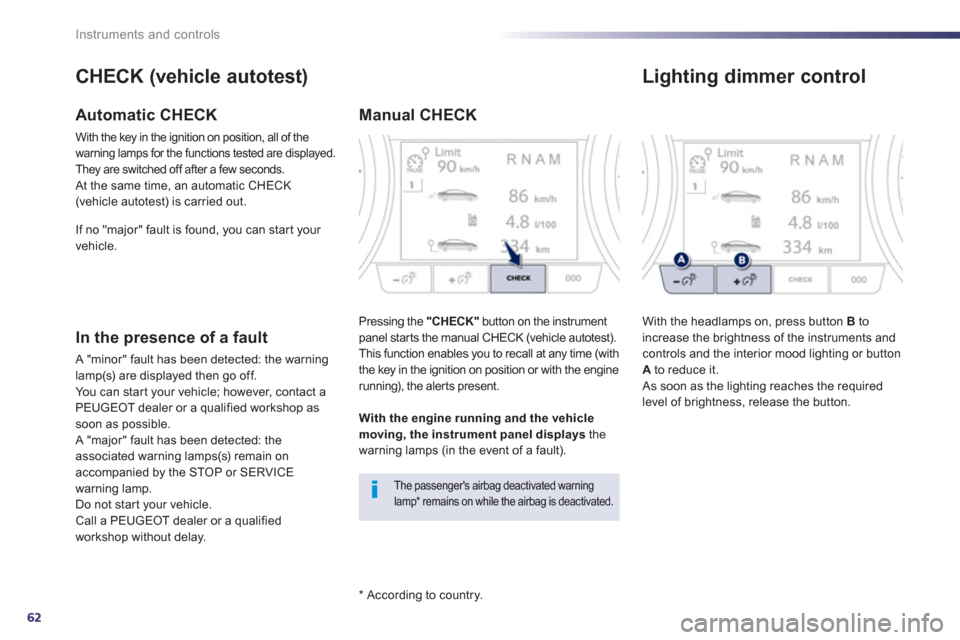
62
Instruments and controls
* According to country.
CHECK (vehicle autotest)
Automatic CHECK
With the key in the ignition on position, all of the
warning lamps for the functions tested are displayed.They are switched off after a few seconds. At the same time, an automatic CHECK(vehicle autotest) is carried out.
In the presence of a fault
A "minor" fault has been detected: the warning
lamp(s) are displayed then go off.You can star t your vehicle; however, contact a
PEUGEOT dealer or a qualified workshop assoon as possible.
A "major" fault has been detected: theassociated warning lamps(s) remain onaccompanied by the STOP or SERVICE
warning lamp.
Do not star t your vehicle. Call a PEUGEOT dealer or a qualified
wor
kshop without delay.
Manual CHECK
Pressing the "CHECK"
button on the instrument
panel star ts the manual CHECK (vehicle autotest).
This function enables you to recall at any time (with
the key in the ignition on position or with the enginerunning), the aler ts present.
The passenger's airbag deactivated warning lamp * remains on while the airbag is deactivated.
With the engine running and the vehiclemoving, the instrument panel displays
the
warning lamps (in the event of a fault). I
f no "major" fault is found, you can star t your
vehicle.
Lighting dimmer control
With the headlamps on, press button Bto
increase the brightness of the instruments and controls and the interior mood lighting or button Ato reduce it.
As soon as the lighting reaches the required
level of brightness, release the button.
Page 67 of 308
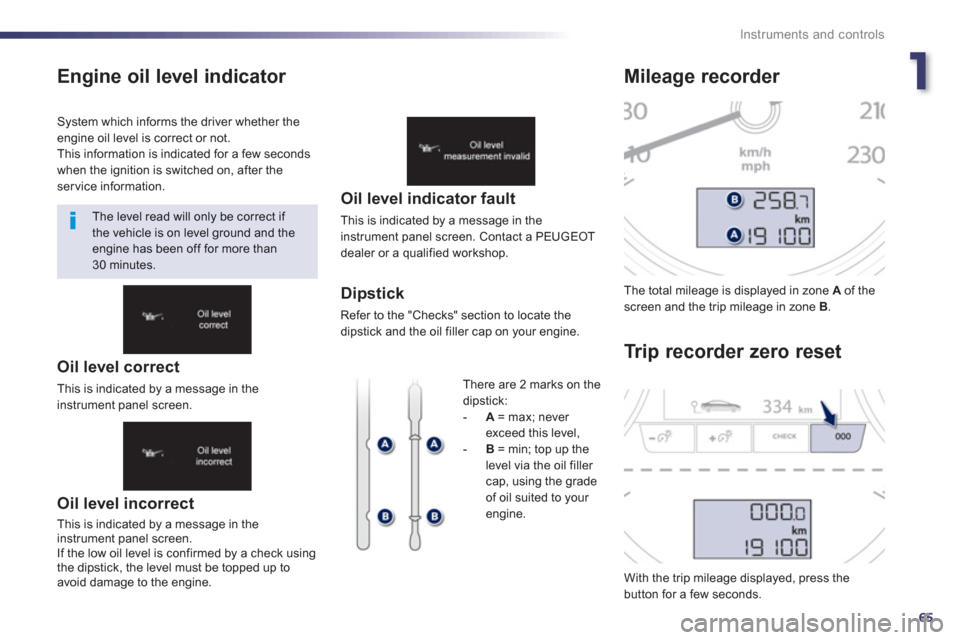
1
65
Instruments and controls
Engine oil level indicator
Oil level incorrect
This is indicated by a message in the
instrument panel screen.
If the low oil level is confirmed b
y a check usingthe dipstick, the level must be topped up to
avoid damage to the engine.
Oil level indicator fault
This is indicated by a message in the instrument panel screen. Contact a PEUGEOT
dealer or a qualified workshop.
Dipstick
Refer to the "Checks" section to locate the
dipstick and the oil filler cap on your engine. The total milea
ge is displayed in zone Aof thescreen and the trip mileage in zone B.
With the trip mileage displayed, press the button for a few seconds.
Mileage recorder
Tr i
p recorder zero reset
System which informs the driver whether theengine oil level is correct or not.
This information is indicated for a few secondswhen the ignition is switched on, after theservice information.
The level read will only be correct if
the vehicle is on level ground and the engine has been off for more than30 minutes.
Th
ere are 2 marks on thedipstick:-A = max; never
exceed this level, -B = min; top up the level via the oil filler cap, using the grade
of oil suited to your
engine.
Oil level correct
This is indicated by a message in theinstrument panel screen.
Page 125 of 308

4
123
Driving
It is recommended that you do not apply the parking brake in very cold conditions (ice) and during towing
(recovery, ...). Deactivate the automaticfunctions and release the parking brakemanually.
Before leaving the vehicle, check that parking brake warning lamps in the instrument panel and the control lever Aare on, not flashing.
The electric parking brake combines
2 operating modes:
-
Automatic Application/Release Application is automatic when the engine stops, release is automatic on use of the accelerator (this mode is activated by
default), -Manual Application/Release Manual application of the parking brake is done by pulling control lever A. manual release is done by pushing and releasing the control lever, while pressing
the brake pedal.
When the driver's door is opened, there is an
audible si
gnal and a message is displayed if the
brake is not applied.
Programming the mode
Depending on the country of sale of the vehicle,
the automatic application when the engine is switched off and the automatic release whenyou press the accelerator can be deactivated. With the vehicle stationary, to apply the parking
brake whether the h
ybrid system is active or off,
pull
control lever A
.
Manual application
Activation / deactivation is done via
the menu in the instrument panel
screen.
The parkin
g brake is then applied and released
manually. The application o
f the parking brake isconfirmed by:
- illumination o
f the braking warning lamp and of the P
warning lamp in
the control lever A ,
- displa
y of a message.
When the driver’s door is opened with the
h
ybrid system active, there is an audible signal
and a message is displayed if the parking brake
has not been applied.
Electric parking brake
If this warning lamp comes on in
the instrument panel, the automatic
m
ode is deactivated.
Page 127 of 308
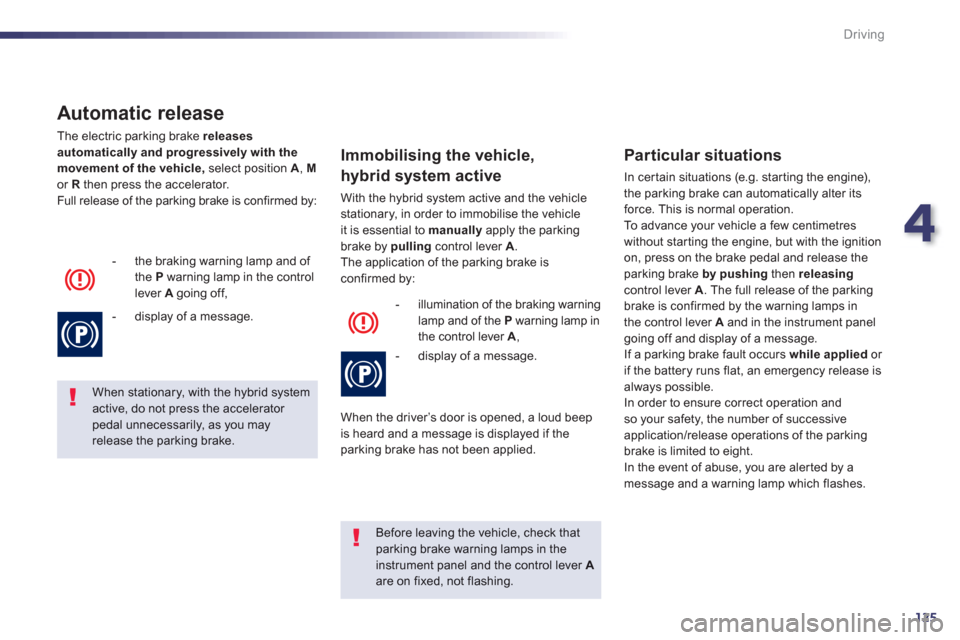
4
125
Driving
Automatic release
The electric parking brake releases automatically and progressively with the
movement of the vehicle,select position A, Mor Rthen press the accelerator.
Full release of the parking brake is confirmed by:
- the brakin
g warning lamp and of
the Pwarning lamp in the control lever A
going off,
- displa
y of a message.
When stationary, with the hybrid system active, do not press the accelerator pedal unnecessarily, as you may release the parking brake.
Before leaving the vehicle, check thatparking brake warning lamps in theinstrument panel and the control lever Aare on fixed, not flashing.
Immobilising the vehicle,
hybrid system active
With the hybrid system active and the vehicle
stationary, in order to immobilise the vehicle it is essential to manually
apply the parking
brake by pulling
control lever A.
The application of the parking brake is confirmed by:
- illumination o
f the braking warning
lamp and of the Pwarning lamp in
the control lever A ,
- displa
y of a message.
When the driver’s door is opened, a loud beep
is heard and a message is displayed if theparking brake has not been applied.
Particular situations
In cer tain situations (e.g. star ting the engine),
the parking brake can automatically alter itsforce. This is normal operation.
To advance your vehicle a few centimetres
without star ting the engine, but with the ignition on, press on the brake pedal and release the
parking brake by pushing then releasingcontrol lever A
. The full release of the parking
brake is confirmed by the warning lamps in
the control lever Aand in the instrument panel going off and display of a message.
If a parking brake fault occurs while appliedor
if the battery runs flat, an emergency release is
always possible.
In order to ensure correct operation and
so your safety, the number of successive
application/release operations of the parkin
g
brake is limited to eight.
In the event of abuse, you are aler ted by a
message and a warning lamp which flashes.
Page 128 of 308
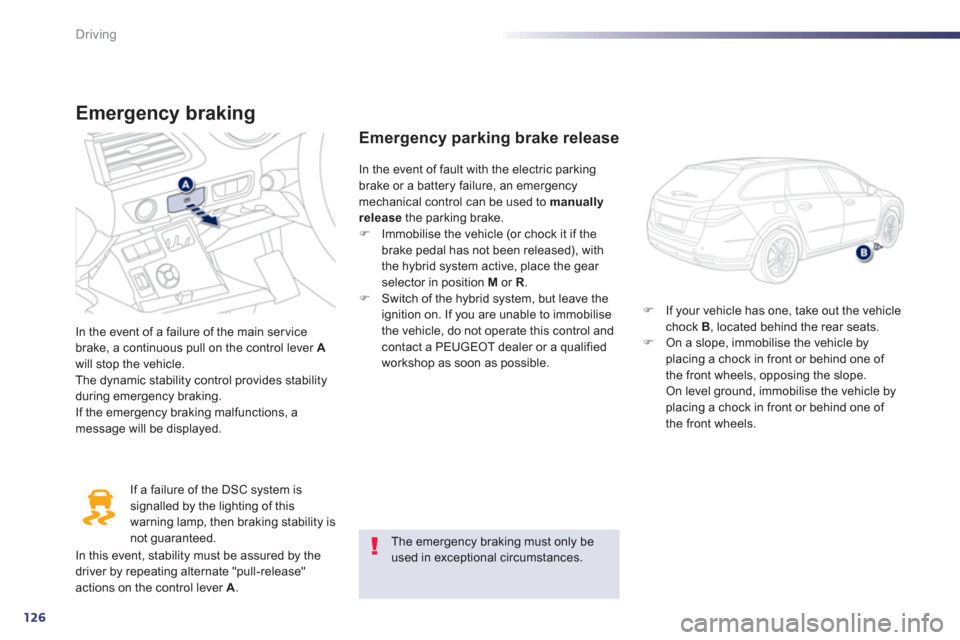
126
Driving
Emergency braking
In the event of a failure of the main servicebrake, a continuous pull on the control lever Awill stop the vehicle.
The dynamic stability control provides stability
during emergency braking.
If the emergency braking malfunctions, a message will be displayed.
I
f a failure of the DSC system is
signalled by the lighting of this
warning lamp, then braking stability is
not
guaranteed.
Emergency parking brake release
�)If your vehicle has one, take out the vehicle chock B , located behind the rear seats.�)On a slope, immobilise the vehicle byplacing a chock in front or behind one of
the front wheels, opposing the slope. On level ground, immobilise the vehicle byplacing a chock in front or behind one of
the front wheels.
In the event o
f fault with the electric parkingbrake or a battery failure, an emergencymechanical control can be used to manually
releasethe parking brake.�) Immobilise the vehicle (or chock it if the
brake pedal has not been released), with
the hybrid system active, place the gear selector in position M or R.�)
Switch of the hybrid system, but leave the
ignition on. If you are unable to immobilise
the vehicle, do not operate this control and contact a PEUGEOT dealer or a qualified
workshop as soon as possible.
The emergency braking must only be used in exceptional circumstances.
In this event, stability must be assured by the
driver by repeating alternate "pull-release"
actions on the control lever A.
Page 131 of 308

4
129
Driving
SituationsConsequences
To a p p ly the electric parking brake: �)
immobilise the vehicle and switch off the ignition. �)
pull the control for at least 5 seconds or until application is complete.
�)
switch on the ignition and check that the electric parking brake
warning lamps come on.
The application is slower than during normal operation.
To release the electric parking brake:�) switch on the ignition. �)
push the control lever and hold it for approximately 3 seconds then
release it.
If the braking warning lamp is flashing or if the warning lamps do not come on with the ignition on, these procedures will not work. Place the
vehicle on level ground and have it checked by a PEUGEOT dealer or aqualified workshop.
and possibl
y
flashing
Display of the message "Parking brake fault" and of the following warning lamps:
- Only the automatic application on switching off the engine andautomatic release on acceleration functions are available.
- The manual application/release of the electric parking brake and theemergency braking are not available.
and possibly
flashing
Display of the message "Battery charge fault".
- You must stop as soon as it is safe to do so. Switch off and
immobilise your vehicle (if necessary, place the a chock under a
wheel).
- Apply the electric parking brake before switching off the engine.
Page 139 of 308

4
137
Driving
Memorising speeds
This memorising of speeds applies to both the speed limiter and the cruise control.
You can memorise u
p to 5 speeds in the system.
By default, some speeds are already memorised.�)Go to the main menu in the instrument
panel screen by pressing the "CONFIG"button.�)Select the "Personalisation-configuration" menu and confirm.
To select a memorised speed:�)press and hold the "+" or
" -" button; the system stopsat the nearest memorisedspeed,
For safety reasons, the driver mustcarry out these operations when stationary, using the instrument panel screen.These operations are only possible when stationary.
Operation
�)
Select the "Vehicle parameters" menu andconfirm.�)
Select the "Driving assistance" line and conform.�)
Select the "Speeds memorised" line andconfirm.�)
Modify the speed. �)
Select " OK" and confirm to save the
modifications.
Selection
�)
press and hold again the "+ " or " - " button toselect another memorised speed.
A reminder of the speed and the state of thesystem (on / off) is displayed in the instrument
panel.
Page 141 of 308
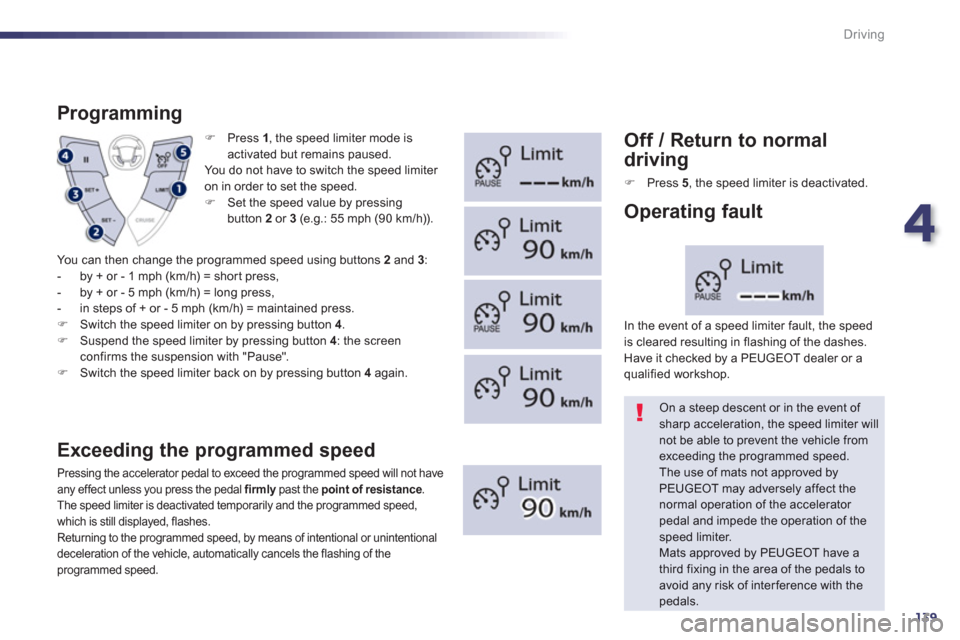
4
139
Driving
�) Press 1, the speed limiter mode is
activated but remains paused.
You do not have to switch the speed limiter
on in order to set the speed.
�) Set the speed value by pressingbutton 2or 3(e.g.: 55 mph (90 km/h)).
Programming
Exceeding the programmed speed
Pressing the accelerator pedal to exceed the programmed speed will not have
any effect unless you press the pedal firmlypast the ypoint of resistance.e The speed limiter is deactivated temporarily and the programmed speed,
which is still displayed, flashes.
Returning to the programmed speed, by means of intentional or unintentional
deceleration of the vehicle, automatically cancels the flashing of the
programmed speed.
Off / Return to normal
driving
�)
Press 5, the speed limiter is deactivated.
On a steep descent or in the event of sharp acceleration, the speed limiter willnot be able to prevent the vehicle from exceeding the programmed speed.
The use of mats not approved byPEUGEOT may adversely affect the normal operation of the accelerator pedal and impede the operation of the
speed limiter.
Mats approved by PEUGEOT have a third fixing in the area of the pedals to avoid any risk of interference with thepedals.
In the event o
f a speed limiter fault, the speed
is cleared resulting in flashing of the dashes.
Have it checked by a PEUGEOT dealer or a qualified workshop.
Operating fault
You can then change the programmed speed using buttons 2
and 3
:
- by + or - 1 mph (km/h) = shor t press,
- by + or - 5 mph (km/h) = long press,
- in steps of + or - 5 mph (km/h) = maintained press. �)Switch the speed limiter on by pressing button 4 . �)Suspend the speed limiter by pressing button 4: the screen confirms the suspension with "Pause".�)Switch the speed limiter back on by pressing button 4
again.
Page 143 of 308
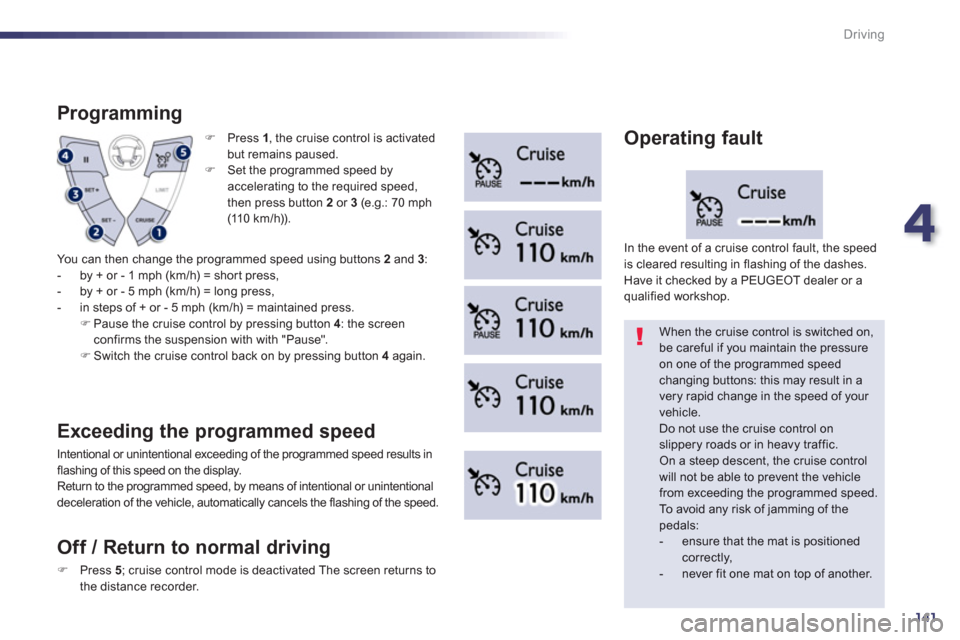
4
141
Driving
�) Press 1, the cruise control is activated but remains paused.
�)
Set the programmed speed by
accelerating to the required speed,
then press button 2or 3(e.g.: 70 mph (11 0 k m / h)).
Programming
You can then change the programmed speed using buttons 2
and 3
:
- by + or - 1 mph (km/h) = shor t press,
- by + or - 5 mph (km/h) = long press,
- in steps of + or - 5 mph (km/h) = maintained press. �)Pause the cruise control by pressing button 4
: the screenconfirms the suspension with with "Pause".�)Switch the cruise control back on by pressing button 4again.
Exceeding the programmed speed
Intentional or unintentional exceeding of the programmed speed results in flashing of this speed on the display.
Return to the programmed speed, by means of intentional or unintentional
deceleration of the vehicle, automatically cancels the flashing of the speed.
When the cruise control is switched on,be careful if you maintain the pressure on one of the programmed speedchanging buttons: this may result in avery rapid change in the speed of your vehicle.
Do not use the cruise control on slippery roads or in heavy traffic. On a steep descent, the cruise control will not be able to prevent the vehicle from exceeding the programmed speed.
To avoid any risk of jamming of the pedals:
- ensure that the mat is positioned correctly,
- never fit one mat on top of another.
In the event o
f a cruise control fault, the speed
is cleared resulting in flashing of the dashes.
Have it checked by a PEUGEOT dealer or a qualified workshop.
Operating fault
Off / Return to normal drivin
g
�)Press 5 ; cruise control mode is deactivated The screen returns to
the distance recorder.
Page 145 of 308

4
143
Driving
In bad weather or in winter, ensure that the sensors are not covered with mud, ice or snow. When reverse gear isengaged, an audible signal (long beep)indicates that the sensors may be dirty.
Cer tain sound sources (motorcycle, lorry, pneumatic drill, etc.) may trigger the audible signals of the parking
sensor system. In th
e event of a malfunction
of the system, when reversegear is engaged this warning
lamp is displayed in the instrument panel
and/or a message appears in the screen,
accompanied by an audible signal (short beep).
Contact a PEUGEOT dealer or a qualified
wor
kshop.
Operating fault
In addition to the rear parking sensors, the front
parking sensors are triggered when an obstacle
is detected in front and the speed of the vehicle
is still below 6 mph
(10 km/h).
The front parking sensors are interrupted if
the vehicle stops for more than three seconds
in
forward gear, if no fur ther obstacles are
detected or when the speed of the vehicle exceeds 6 mph (10 km/h).
Front par king sensors
The function will be deactivated automatically if a trailer is being towedor a bicycle carrier is fitted (vehicle fitted with a towbar or bicycle carrier recommended by PEUGEOT).
Deactivation / Activation of thefront and rear parking sensors
The function is deactivated by pressing this button.
The indicator lamp in the button comes on.
Pressin
g this button again reactivates the function.
The indicator lamp in the button goes off.
The sound emitted by the speaker (frontor rear) indicates whether the obstacle is in front or behind.